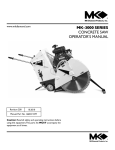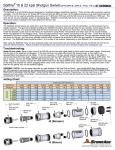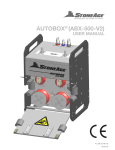Download Badger BA-P8, BA-MP9 Tool Manual
Transcript
BadgerTM 6" Self-Rotary Swivel (BA-P8, BA-MP9 & BA-M24) Description: The Badger™ P8, MP9 and M24 Rotary Waterblast Nozzles were designed to waterblast clean pipes as small as 6 inches with elbows. The BA-P8 has a 1/2 npt female inlet connection and a maximum working pressure of 15,000 psi (1035 bar). The BA-MP9 has a 9/16 medium pressure female inlet connection and a maximum working pressure of 22,000 psi (1500 bar). The BA-M24 has a metric M24x1.5 female face seal inlet connection and a maximum working pressure of 22,000 psi (1500 bar). The Badger™ has an adjustable speed mechanism that allows rotation speed to be changed. For the fastest speed setting, the Shaft Adjust Sleeve (BA 303) is backed out all the way against the shoulder of the shaft. The slowest speed setting is about 1-1/4 turn inward. Do not force the adjustment in this direction. To adjust the speed, hold the wrench flats on the shaft while turning the Shaft Adjust Sleeve with wrench (BA 300). This Badger uses fast viscous fluid for speed control and bearing lubrication. The Badger™ heads have 1/4 npt ports; one at 15 degrees, two at 100 degrees, and two at 135 degrees. Flow Range, gpm Engraved on each head is R21, R31 or R40; this number is the offset of the head that makes it rotate. Press. psi R40 R31 R21 The flow range for each head is given in the table; nozzle sizes must be selected to fit within this 10,000 15-24 21-31 31-55 flow range. If the flow is less than the range shown, the tool will not rotate; it is okay to use more 15,000 15-24 23-33 33-55 than the allowable, but the tool MUST be slowed down using the adjustable speed mechanism to 22,000 14-21 21-30 30-43 prevent overspeeding and damaging the tool. Operation: The first step is to determine the jet sizes. Jet thrust is used to pull the tool through the pipe. An estimate of the amount of pulling force required is useful and depends on the number of elbows and any vertical climbs that must be made. On a horizontal run with no elbows, 1 pound of pull is required for every ten feet. When climbing vertically, the pulling force must equal the weight of the tool and the hose. Typically, larger jet sizes using 50 to 80 percent of the total flow are used in the back ports. As little as 10 percent of the total flow is given to the front jet, because it pushes the wrong direction and is only used to open up blockages. The remaining flow goes to the 100 degree ports, which do help pull as well. Nozzles selected should be matched pairs, except the front jet. When installing nozzles, we recommend using Parker Thread Mate and Teflon tape. Because of the short length of the Badger™, the tool turn can around in large pipes and come back at the operator at a high rate of speed. If cleaning larger pipes, a rigid pipe "stinger" should be used between the hose and the tool. It is recommended that the rigid length of the tool including hose end is one and a half times the inside diameter of the pipe being cleaned. Make sure there is an operator controlled dump in the system, operated by the person closest to the cleaning job. Flush out the high pressure hoses before connecting the Badger™. It is recommended that the hose be marked a few feet from the end with a piece of tape so the operator knows when to stop on the way back out. Position the tool in the pipe opening. Close the dump and slowly bring up to pressure the first time to make sure no nozzles are plugged and the jet thrust is correct. The Badger™ should begin to slowly rotate. Once operating pressure is reached, feed the tool into the pipe to begin the cleaning job. Allow the jets time to do their work by feeding the hose out at a controlled rate. When the work is complete and the tool is disconnected from the hose, blow out all water to prolong the life of the tool. A small amount of oil can be blown into the tool as well. 1 1/2 times pipe ID rigid "stinger" IMPROPER USE: Badger will turn around in large diameter pipe VERY DANGEROUS! PROPER USE: Badger with rigid "stinger" to prevent turnaround, still able to pass thru elbows Troubleshooting: High-pressure seal leak: There is a spring behind the high pressure seal that should keep the seal seated at all pressures. A continuous leak at operating pressure from the weep holes indicates the need to replace the HP Seal and Seat. HP Seals wearing out too quickly can be an indication that the shaft bore is worn, the HP Seat is installed upside-down, or the tool is over spinning. Over spinning is caused by having the speed adjustment set too fast, low or contaminated viscous fluid, or water in the fluid chamber (replace shaft seals.) Refilling the viscous fluid every 30-40 hours of operation is important for proper speed control. Only use StoneAge recommended viscous fluid. Tool will not rotate: Check the speed adjustment setting, if it is adjusted too far in it can prevent the tool from rotating. Check the nozzles for plugging or wear (nozzles have to be removed to check for obstructions), Check that the nozzle sizes are correct for the desired flow and that the desired flow matches the head flow range. Check that the nozzle sizes are installed in a balanced configuration. If the tool feels rough when manually rotating the head, this indicates internal damage. Replace bearings, shaft seals, viscous fluid, and check the Inner and Outer Discs for flatness. These discs can be deformed if tool is reassembled when discs are not properly aligned with BA 318 Pins. Maintenance: The most important item in maintaining the Badger™ is keeping the tool full of viscous fluid, which controls the rotation speed. As the viscous fluid is lost or contaminated, the rotation speed of the tool will increase, which shortens the high pressure seal and bearing life. To fill the Badger™ with viscous fluid: BJ 026 Port Screw (in Nut) BC 410 Syringe 1. Remove the Port Screws (BJ 026) in the Nut and Head. 2. Fill the Syringe (BC 410) with viscous fluid by removing the end near the handle, pulling out the plunger, and pouring the viscous fluid in from the back end. BJ 026 Port Screw (in Head) 3. Thread the syringe end into the port in the Head, and squeeze fresh viscous fluid in until clean viscous fluid comes out the port in the Nut. Hold the tool so the port in the Nut is the highest point. 4. Remove the Syringe and install the Port Screws. BJ 026 Port Screw BA 312 O-Ring BA 318 Pin BA 307 Shaft Seal BA 311 Bearing BA 340-RXX Head Available Maintenance Kits: BA BA BA BA BJ 011-C Seat, Carbide 600-P8/MP9 602-P8/MP9 610-P8/MP9 612-P8/MP9 BA 313 Wave Spring Service Kit (Includes items needed for maintenance) Seal Kit (Includes parts needed for one seal change) Overhaul Kit (Includes parts needed for tool rebuild) Tool Kit (Includes tools to aid assembly) BA 310 O-Ring (2) BJ 012-TRO H.P. Seal BA 301-P8 Shaft, 15 kpsi or BA 301-MP9 Shaft, 22 kpsi or BA 301-M24x1.5 Shaft, 22 kpsi CST 141 Retaining Ring SM 116 O-Ring (4) BA 316 Disc, Outer (4) BA 315 Disc, Inner (5) BJ 008 O-Ring (3) BA 303 Shaft Adjust Sleeve BA 309 Bearing BJ 026 Port Screw BA 302 Inlet Nut BA 308 Shaft Seal BA 318 Pin BA 330 Wear Ring © 04/04/2014 StoneAge®, All Rights Reserved TM Badger 6" Self-Rotary Swivel (BA-P8, BA-MP9 & BA-M24) Disassembly: 1. Unscrew the Nut (BA 302) from the Head (BA 340). 2. Pull the Shaft (BA 301P8/M9/M24x1.5) out of the Head. 4. Remove the Bearing (BA 311) and Retaining Ring (CST 141) from the Shaft. 6. Press the Bearing (BA 309) off of the Shaft Adjust Sleeve. 9. Remove the Shaft Seal (BA 308) if it is damaged. 5. Pull the Discs (BA 315, BA 316) and O-Rings (SM 116 & BJ 008) off of the Shaft. BA 311 Bearing 7. There is no need to remove the Pins (BA 318) from the Shaft; however, if they fall out do not lose them. 10. Remove the Port Screw (BJ 026) from the Nut. BA 302 Nut CST 141 Retaining Ring BA 315 Disc, Inner (5) BA 330 Wear Ring BA 316 Disc, Outer (4) BA 301-P8 or BA 301-M9 or BA 301-M24x1.5 Shaft BA 340 Head BA 308 Shaft Seal 8. If the Shaft Adjust Sleeve (BA 303) fails to remain in the set position while the tool is in use, it may be necessary to unscrew the Shaft (BA 301-P8/MP9/M24x1.5) from the Shaft Adjust Sleeve in order to replace the (2) O-Rings (BA 310). Normally it is not necessary to disassemble the Shaft from the Adjust Sleeve. BJ 008 O-Ring (3) BA 303 Shaft Adjust Sleeve SM 116 O-Ring (4) BA 309 Bearing BA 302 Nut BJ 026 Port Screw 11. Remove the Port Screw (BJ 026) from the Head. 12. Remove the Bearing (BA 311) (Bearing may be on shaft), Shaft Seal (BA 307) and O-Ring (BA 312) if they are damaged. 13. There is no need to remove the Pins (BA 318); however, if they fall out, do not lose them. BA 310 O-Ring (2) 3. Remove the Seat (BJ 011-C), H.P. Seal (BJ 012-TRO), and Wave Spring (BA 313) from the bore of the Shaft. BJ 011-C Seat BJ 012-TRO H.P. Seal BA 318 Pins (2) BA 307 Shaft Seal BA 318 Pin (2) BA 301-P8 or BA 301-MP9 or BA 301-M24x1.5 Shaft BA 313 Wave Spring BA 312 O-Ring BA 340 Head BJ 026 Port Screw 8. Push down on top disc and install the Retaining Ring (CST 141) in the groove around Shaft. Install Bearing (BA 311) on shaft. Assembly: 1. Press Bearing (BA 309) onto Shaft Adjust Sleeve(BA 303). 2. Check that Pins (BA 318) are installed in Shaft. BA 311 Bearing BJ 011-C Seat 9. Insert Wave Spring (BA 313) into bore of Shaft. Apply grease to and install the H.P. Seal (BJ 012-TRO) in bore of Shaft. CST 141 Retaining Ring 10. Apply grease to the flat face of the Seat (BJ 011-C) and place in bore of Shaft, on top of BA 313 Wave Spring Seal, as shown. 11. Install Shaft Seals (BA 307 and BA 308) in the Nut (BA 302) and Head (BA 340) as shown. 13. Check that the Pins (BA 318) are installed in the Head. BA 312 O-Ring BA 318 Pin (2) lip with spring up BJ 008 O-Ring (3) BA 307 Shaft Seal BA 340 Head 7. Repeat steps 4 thru 6, until there are four Outer Discs and five Inner Discs on Shaft. Note that there is no outer O-Ring on the Inner Discs at each end of the stack. 14. Align the notches on the Outer Discs with the pins in the Head; slide shaft assembly into the Head, taking care that the outer O-Rings remain captured between the Discs. 16. Use syringe to fill the tool with viscous fluid as shown in the Maintenance Section; install the Port Screws (BJ 026). 4. Place an O-Ring (SM 116) on top of this Disc, stretched around the pins. 6, Place another Inner Disc, and also place an O-Ring (BJ 008) around the outer edge of this Disc. BJ 012-TRO H.P. Seal BA 313 Wave Spring lip with spring up BA 308 Shaft Seal BA 302 Nut 15. Apply anti-seize to threads on Head; install Wear Ring (BA 330) onto the Nut (BA 302); thread the Nut onto the Head. Tighten to 50 ft-lb. 3. Place an Inner Disc (BA 315) on Shaft, aligning with pins. BA 316 5. Place an Outer Disc (4) Outer Disc BA 315 (BA 316) Inner Disc (5) around the outside of this O-Ring. flat face 12. Place O-Ring (BA 312) over threads and into groove of Head. BA 303 Shaft Adjust Sleeve SM 116 O-Ring (4) BJ 011-C Seat, Carbide BJ 012-TRO H.P. Seal BA 318 Pins (2) BA 309 Bearing chamfered face BJ 026 Port Screw BJ 026 Port Screw BA 330 Wear Ring © 04/04/2014 StoneAge®, All Rights Reserved












